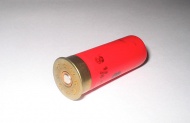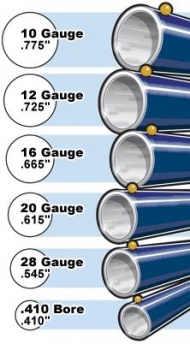How to choose shotgun shells and chokes
From Gunsopedia
(Redirected from How to: Choose shotgun shells and chokes)
Contents |
[edit] Background on Shotgun Shells
There are (in the broadest sense) two basic types of shotgun shells, each with two sub-types:
- Shotshells: shells filled with multiple round pellets. Such loads should always be fired from smooth (non-rifled) barrels.
- Slugs: shells loaded with a single, heavy, "bullet"
- "rifled" slugs, for use in smooth-bore barrels
- "sabot" slugs, for use in rifled barrels
[edit] Shotshells
Shotshells are generally loaded with lead balls, sometimes steel for legal reasons, and occasionally exotic extra-dense alloys.
- 12ga shotshells (the most common) are available in 3 lengths:
- Regular 2 3/4"
- Magnum 3" (more gunpowder, more lead, more "ouch!" to both target and shooter)
- Super-magnum 3 1/2" (more, more, more!)
- Larger shot numbers mean smaller pellets:
- The diameter of birdshot is equal to .17" minus the shot number; #4 shot is .13" in diameter.
- Same goes for buckshot; 000 is .35", 00 is .33", #4 buck is .25".
- Larger shot penetrates deeper, so it is used on larger animals.
- Small critters: doves, squirrels, or the clay pigeons used in competition, can be taken with shot as small at #8 (#7 1/2 is recommended for trap shooting). Some people like to use larger shot because it can kill at slightly longer range and reduces the number of pellets you have to remove from your food. Crunchy = bad.
- Larger critters, such as pheasants, turkeys, or rabbits should be taken with slightly larger shot such as #6 or #4.
- Even larger critters, such as ducks or geese, require larger shot, compounded by the use of steel, #4-BB is recommended for for ducks, #1-TT (TT = .21") for geese.
- The largest critters that buckshot is suited for, such as deer, coyotes, men, or - perhaps - already wounded lions, should be shot with pellets no smaller than #4 buck.
- Steel shot is less dense than lead, so it loses speed faster in air and penetrates less in tissue. Larger shot (rule-of-thumb: 2 birdshot sizes bigger) is required to get performance similar to lead.
- The pattern (how and how much the load spreads out during flight) of a load of shot changes depending upon the existence of a choke in the barrel. The choke does two things:
- Dents lead that passes through it. This is usually considered a bad thing, as it makes the pellets disperse more - and disperse erratically, making for uneven patterns.
- The tighter the choke, the more the lead will be dented.
- The more lead in a shotgun load, the more serious this effect is.
- The softer the lead in a shotgun load, the worse the pellets will be deformed.
- Buffered shotgun shells pack padding around the lead pellets to protect them. This results in tighter patterns.
- Helps make all the pellets stay in one cloud. Tighter chokes do this to a higher degree. Yes, this is opposite to the previous affect.
- Dents lead that passes through it. This is usually considered a bad thing, as it makes the pellets disperse more - and disperse erratically, making for uneven patterns.
- Most chokes anymore are interchangeable; the inside of the end of the barrel is threaded, and chokes can be screwed in and out at will. Generally, the following chokes are the most common:
- Cylinder bore, which has no restriction, throws open but very uniform patterns; it is useful for close-range shooting
- Skeet choke
- Improved cylinder
- Light Modified choke
- Modified choke
- Improved Modified choke
- Light Full choke
- Full choke, which has a lot of restriction, throws very tight patterns when fed quality shot. However, when fed soft lead, a full choke tends to shoot gawd-awful patterns: uneven and possibly larger than those produced by a looser choke.
[edit] Slugs
Slugs, as mentioned, are large pieces of lead propelled by powder, loaded one per shell.
- Slug power is determined in the same way as buckshot, with standard, magnum, and super-magnum loadings. With magnum and super-magnum are often loaded with heavier slugs.
- The "rifled" slug, used in smooth-bore shotguns (most) has rifling or ribs on the slug itself. These ribs are designed to prevent damage to the gun if fired through a barrel with some choke.
- Sabot slugs are for rifled barrels.
- A sabot is a covering for an object which is smaller than the bore which it travels through. That is, sabot slugs wear a plastic jacket that is discarded after they leave the barrel.
- Sabot slugs are generally more accurate, higher velocity, and more aerodynamic than rifled slugs, but they require a rifled barrel to be fired accurately.
- Both types of slugs are fairly low velocity, and thus have rainbow-shaped trajectories that are not helpful to long-range shooting. It is fair to say that rifled slugs can reach out to 100 yards without too much difficulty; sabot slugs about 150 yards.
Note that generally buckshot and slugs in the same size shell as bird shot will have much more recoil than bird shot. So, the first time firing slugs or buck shot, be prepared for extra kick (if you use magnums or super-magnums, be prepared for a lot of extra kick).
[edit] Steps
[edit] Selecting Shot Loads
- Check the size of shells you need to buy. It'd be damn embarrassing to come back from the store with 12ga shells for your 20ga shotgun! (don't ask...)
- Decide what you are to be shooting at, and at what kind of range you expect to engage your target.
- Select a shell/choke combination, with the proper size shot, that you believe will produce the patterns you desire. This is an art, or at best, an inexact science.
- Shoot one of your shot-shells at a piece of paper big enough to record the impact of all, or nearly all, of the pellets at the range you expect to use the load. At 40 yards, expect to get a pattern with a diameter of roughly 20-40", depending on the choke and shotgun shell used.
- Examine the pattern:
- How big is the main cluster of holes? Will it be hard to hit a moving target with the pattern?
- How dense is the pattern in this main cluster? Will enough pellets hit the target to kill/break it?
- Is the pattern uniform? Are there large gaps in the pattern where targets could escape?
- If you're pleased with the results of this test, you have found a shotshell which will work in your gun with this choke for this purpose. If you change your range substantially, your conclusion may change.
- If you're not pleased, change some variable in the shot: choke, shell, or range; and try again. Keep experimenting.
[edit] Selecting Slugs
- If you have the cash, buy a whole bunch of different types of slugs in the proper gauge.
- For lighter game (deer), select a slug which will expand.
- For heavier game (elk, buffalo, bears), select a slug which won't break up or fragment if it hits a large bone.
- Shoot 3-or-5 shot "groups" (several shots at the same point of aim from a stable rest, using the sights) with the slugs at paper at a reasonable range; say 50 yards for "rifled" slugs, 100 yards for sabot slugs.
- Pick a slug which produces acceptable patterns and satisfies your desire for target damage.
- Sight in your shotgun in the same way you'd sight in a rifle.
[edit] Tips
- If you don't have time or space to pattern your load, all hope is not lost; you just won't be able to check if the rules of thumb apply to your barrel.
- If you don't know the range you will be using your shot shells, it is customary to pattern birdshot at 40 yards and to pattern (defensive) buckshot at 20-25 yards.
- If your patterns are the wrong size or don't have the density required to kill game, use a tighter or looser choke as required.
- If your patterns are uneven, you are probably trying to push too much soft lead through too small a hole (keep the jokes to yourself). Sometimes less lead and a looser choke will actually allow you to be more effective at longer range.
[edit] Warnings
- Non-toxic (i.e., not lead) shot is often required when hunting ducks and other waterfowl in many jurisdictions.
- Don't shoot steel or other very hard shot through a full choke; you are likely to damage it.
- For the same reason, don't shoot slugs through a tight choke.
- Small people/kids are not recommended to shoot anything other than bird shot or target shot, hi-velocity or buck shot has enough recoil to damage your shoulder if you don't hold the gun right.
[edit] See also
[edit] Sources
- Brister's Shotgunning: The Art and the Science
- Remington shotgun ammo listings



